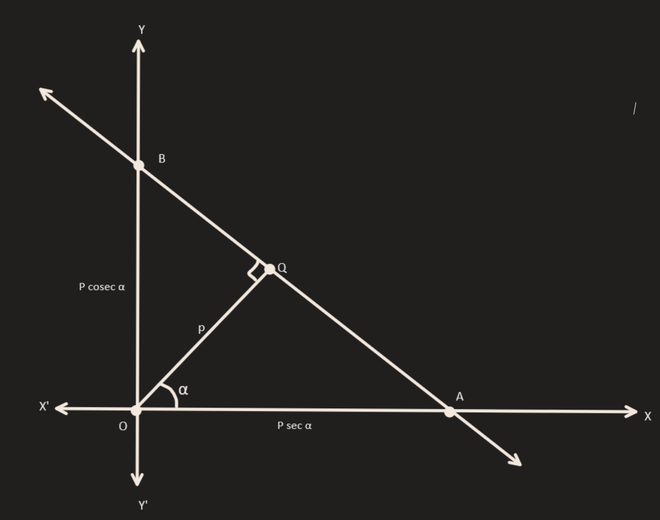线是最简单的几何形状。它没有端点,并且在两个方向上一直延伸到无穷大。 “直线”一词仅表示没有“弯曲”。线上任意两点之间的梯度是相同的。因此, 我们可以说,如果线上任意两点之间的梯度相同,那么轨迹就是一条直线。因此,让我们看看该行中可以表示的不同方式是什么。
线的不同形式
- Point Slope Form
- Two – Point Form
- Slope – Intercept Form
- Intercept Form
- Normal Form
点–坡度形式
通过点(x 1 ,y 1 )和斜率’m’的直线方程可写为:
![]()
证明:
Let the point that lies on the curve be (x1, y1) and any general point can be denoted by (h, k).
So, the slope of the line can be written as
Slope=(k-y1) / (h-x1)
Also, we know that the slope of line is m.
Hence,
(k-y1) / (h-x1)= m
Replace k by y and h by x
And, we get y – y1 = m(x – x1 )
例1.写出通过(5,6)且斜率等于3的直线的方程式
解决方案:
Putting the value of (x1,y1) as (5,6) and m = 3, we get
y – 6 = 3* (x -5)
y – 6 = 3x – 15
y = 3x – 9
例2:写出通过(0,0)且斜率等于1的直线的方程式
解决方案:
Putting the value of (x1,y1) as (0,0) and m=1, we get
y – 0 = 1* (x -0)
y = x
两点式
通过点(x 1 ,y 1 )和(x 2 ,y 2 )的直线方程可写为: ![]()
证明:
Since we know any two points on the line, we can write the slope of the line as
m = (y2-y1) / (x2-x1)
And we also know from point slope form that
y-y1 = m(x-x1)
Substituting the value of m in the above equation, we get
y-y1 = ((y2-y1) / (x2-x1) * (x-x1)
示例1.编写通过(5,6)和(6,7)的直线的方程式
解决方案:
Putting the value of (x1,y1) as (5,6) and (x2,y2) as (6,7) , we get
y – 6 = (7-6)/(6-5) * (x -5)
y – 6 = 1* (x – 5)
y = x + 1
示例2.写出通过(0,5)和(5,5)的直线的方程式
解决方案:
Putting the value of (x1,y1) as (0,5) and (x2,y2) as (5,5), we get
y – 5 = (5-5)/(5-0) * (x -0)
y = 0
坡度-截距形式
斜率为’m’且在y轴上截取为’c’的直线方程可写为: ![]()
证明:
Since y-intercept=c
Equation of line passing through (0,c) is given by
y – c = m(x-0)
y = mx + c
示例1.将斜率= 5且y截距为3的直线的方程写成
解决方案:
Putting the value of m=5 and c=3 in Equation y = mx + c
y = 5x+3
例2编写斜率= 1且y截距为1的直线的方程
解决方案:
Putting the value of m=1 and c=1 in Equation y = mx + c
y = x+1
拦截形式
x轴上的线切割截距’a’和y轴上的’b’的方程可写为: ![]()
证明:
So we know that the line passes through the point (a,0) and (0,b), we can write the equation using two point form
y – y1 = (y2 – y1) / (x2 – x1) * (x – x1)
Putting x1 = a, y1 = 0, x2 = 0 , y2 = b
We get,
y = (b/(-a) * (x-a)
Dividing both sides by b and simplify RHS we get
y/b = -(x/a)+1
⇒ x/a + y/b =1
示例1.编写以x截距为5且y截距为3的直线的方程式
解决方案:
Putting the value of a=5 and b=3 in Equation x / a + y / b = 1
x/5 + y/3 =1
示例2.写出x截距为1且y截距为1的直线的方程式
解决方案:
Putting the value of a=1 and b=1 in Equation x / a + y / b = 1
x/1 + y/1 =1
正常形式
垂直于原点的垂直线的长度为’p’且与x轴的正方向形成角度’∝’的直线方程为: ![]()
证明:
Let the line AB be such that the length of the perpendicular OQ from the origin O to the line be p and From the diagram, using the intercept form we get Equation of line AB is x/p sec∝ + y/p cosec∝ =1 or xcos∝ + ysin∝ =p
示例1.编写一条直线方程,其直线从原点开始的长度为5个单位,并且该直线与x轴的正方向成45 0的角度。
解决方案:
So, basically we are given the value of p=5 and ∝=450
Putting the values in the above equation we get,
x /√2 + y√2 = 5
x + y = 5√2
示例2.编写一条直线方程,其直线与原点的垂直线长度为1个单位,并且该垂直线与x轴的正方向形成60 0的角度。
解决方案:
So, basically we are given the value of p=1 and ∝=600
Putting the values in the above equation we get,
x * (1/2) + y * (√3/2) = 1
x + y√3 = 2
